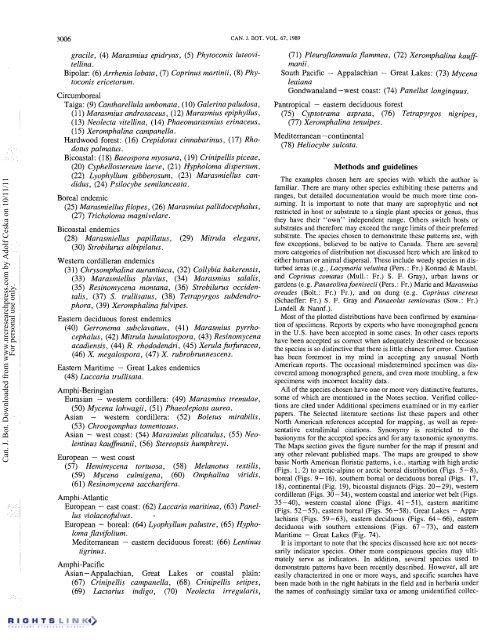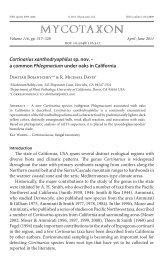Redhead Fungal Biogeography.pdf - Mushroom Hobby
Redhead Fungal Biogeography.pdf - Mushroom Hobby
Redhead Fungal Biogeography.pdf - Mushroom Hobby
Create successful ePaper yourself
Turn your PDF publications into a flip-book with our unique Google optimized e-Paper software.
Can. J. Bot. Downloaded from www.nrcresearchpress.com by Adolf Ceska on 10/11/11<br />
For personal use only.<br />
3006<br />
gracile, (4) Marasmius epidryas, (5) Phytoconis luteovi-<br />
tellina.<br />
Bipolar: (6) Arrhenia lobata, (7) Coprinus martinii, (8) Phy-<br />
toconis ericetorum .<br />
Circumboreal<br />
Taiga: (9) Cantharellula urnbonata, (10) Galerinapaludosa,<br />
(1 1) Marasmius androsaceus, (12) Marasmius epiphyllus,<br />
(13) Neolecta vitellina, (14) Phaeomarasmius erinaceus,<br />
(1 5) Xeromphalina campanella.<br />
Hardwood forest: (16) Crepidotus cinnabarinus, (17) Rho-<br />
dotus palmatus.<br />
Bicoastal: (1 8) Baeospora myosura, (19) Crinipellis piceae,<br />
(20) Cyphellostereum laeve, (2 1) Hypholoma dispersum,<br />
(22) Lyophyllum gibberosum, (23) Marasmiellus can-<br />
didus, (24) Psilocybe semilanceata.<br />
Boreal endemic<br />
(25) Marasmiellusfilopes, (26) Marasmius pallidocephalus,<br />
(27) Tricholoma magnivelare.<br />
Bicoastal endemics<br />
(28) Marasmiellus papillatus, (29) Mitrula elegans,<br />
(30) Strobilurus albipilatus.<br />
Western cordilleran endemics<br />
(31) Chrysomphalina aurantiaca, (32) Collybia bakerensis,<br />
(33) Marasmiellus pluvius, (34) Marasmius salalis,<br />
(35) Resinomycena montana, (36) Strobilurus occiden-<br />
talis, (37) S. trullisatus, (38) Tetrapyrgos subdendro-<br />
phora, (39) Xeromphalina fulvipes.<br />
Eastern deciduous forest endemics<br />
(40) Gerronema subclavatum, (41) Marasmius pyrrho-<br />
cephalus, (42) Mitrula lunulatospora , (43) Resinomycena<br />
acadiensis, (44) R. rhododendri, (45) Xerula fu&racea ,<br />
(46) X. megalospora, (47) X. rubrobrunnescens.<br />
Eastern Maritime - Great Lakes endemics<br />
(48) Laccaria trullisata.<br />
Amphi-Beringian<br />
Eurasian - western cordillera: (49) Marasmius tremulae,<br />
(50) Mycena lohwagii, (51) Phaeolepiota aurea.<br />
Asian - western cordillera: (52) Boletus mirabilis,<br />
(53) Chroogomphus tomentosus.<br />
Asian - west coast: (54) Marasmius plicatulus, (55) Neo-<br />
lentinus kaufianii, (56) Stereopsis humphreyi.<br />
European - west coast<br />
(57) Hemimycena tortuosa, (58) Melanotus textilis,<br />
(59) Mycena culmigena, (60) Omphalina viridis,<br />
(61) Resinomycena saccharifera.<br />
Amphi-Atlantic<br />
European - east coast: (62) Laccaria maritima, (63) Panel-<br />
lus violaceofulvus. .<br />
European - boreal: (64) Lyophyllum palustre, (65) Hypho-<br />
loma jlavifolium.<br />
Mediterranean - eastern deciduous forest: (66) Lentinus<br />
tigrinus.<br />
Amphi-Pacific<br />
Asian-Appalachian, Great Lakes or coastal plain:<br />
(67) Crinipellis campanella, (68) Crinipellis setipes,<br />
(69) Lactarius indigo, (70) Neolecta irregularis,<br />
CAN. I. BOT. VOL. 67, 1989<br />
(7 1) Pleurojlammula flammea , (72) Xeromphalina kauff-<br />
manii.<br />
South Pacific - Appalachian - Great Lakes: (73) Mycena<br />
leaiana<br />
Gondwanaland-west coast: (74) Panellus longinquus.<br />
Pantropical - eastern deciduous forest<br />
(75) Cyptotrama asprata, (76) Tetrapyrgos nigripes,<br />
(77) Xeromphalina tenuipes.<br />
Mediterranean -continental<br />
(78) Heliocybe sulcata.<br />
Methods and guidelines<br />
The examples chosen here are species with which the author is<br />
familiar. There are many other species exhibiting these patterns and<br />
ranges, but detailed documentation would be much more time con-<br />
suming. It is important to note that many are saprophytic and not<br />
restricted in host or substrate to a single plant species or genus, thus<br />
they have their "own" independent range. Others switch hosts or<br />
substrates and therefore may exceed the range limits of their preferred<br />
substrate. The species chosen to demonstrate these patterns are, with<br />
few exceptions, believed to be native to Canada. There are several<br />
more categories of distribution not discussed here which are linked to<br />
either human or animal dispersal. These include weedy species in dis-<br />
turbed areas (e.g., Lacymaria velutina (Pers.: Fr.) Konrad & Maubl.<br />
and Coprinus comatus (Mull.: Fr.) S. F. Gray), urban lawns or<br />
gardens (e.g. Panaeolina foenisecii (Pers. : Fr.) Marie and Marasmius<br />
oreades (Bolt.: Fr.) Fr.), and on dung (e.g. Coprinus cinereus<br />
(Schaeffer: Fr.) S. F. Gray and Panaeolus semiovatus (Sow.: Fr.)<br />
Lundell & Nannf.).<br />
Most of the plotted distributions have been confirmed by examina-<br />
tion of specimens. Reports by experts who have monographed genera<br />
in the U.S. have been accepted in some cases. In other cases reports<br />
have been accepted as correct when adequately described or because<br />
the species is so distinctive that there is little chance for error. Caution<br />
has been foremost in my mind in accepting any unusual North<br />
American reports. The occasional misdetennined specimen was dis-<br />
covered among monographed genera, and even more troubling, a few<br />
specimens with incorrect locality data.<br />
All of the species chosen have one or more very distinctive features,<br />
some of which are mentioned in the Notes section. Verified collec-<br />
tions are cited under Additional specimens examined or in my earlier<br />
papers. The Selected literature sections list these papers and other<br />
North American references accepted for mapping, as well as repre-<br />
sentative extralimital citations. Synonymy is restricted to the<br />
basionyms for the accepted species and for any taxonomic synonyms.<br />
The Maps section gives the figure number for the map if present and<br />
any other relevant-published maps. The maps are groupkd to show<br />
basic North American floristic patterns, i.e., starting with high arctic<br />
(Figs. 1, 2) to arctic-alpine or arctic boreal distribution (Figs. 5 -8),<br />
boreal (Figs. 9-16), southern boreal or deciduous boreal (Figs. 17,<br />
18), continental (Fig. 19), bicoastal disjuncts (Figs. 20-29), western<br />
cordilleran (Figs. 30-34), western coastal and interior wet belt (Figs.<br />
35-40), western coastal alone (Figs. 41 -51), eastern maritime<br />
(Figs. 52-55), eastern boreal (Figs. 56-58), Great Lakes - Appa-<br />
lachians (Figs. 59-63), eastern deciduous (Figs. 64-66), eastern<br />
deciduous with southern extensions (Figs. 67-73), and eastern<br />
Maritime - Great Lakes (Fig. 74).<br />
It is important to note that the species discussed here are not neces-<br />
sarily indicator species. Other more conspicuous species may ulti-<br />
mately serve as indicators. In addition, several species used to<br />
demonstrate patterns have been recently described. However, all are<br />
easily characterized in one or more ways, and specific searches have<br />
been made both in the right habitats in the field and in herbaria under<br />
the names of confusingly similar taxa or among unidentified collec-



